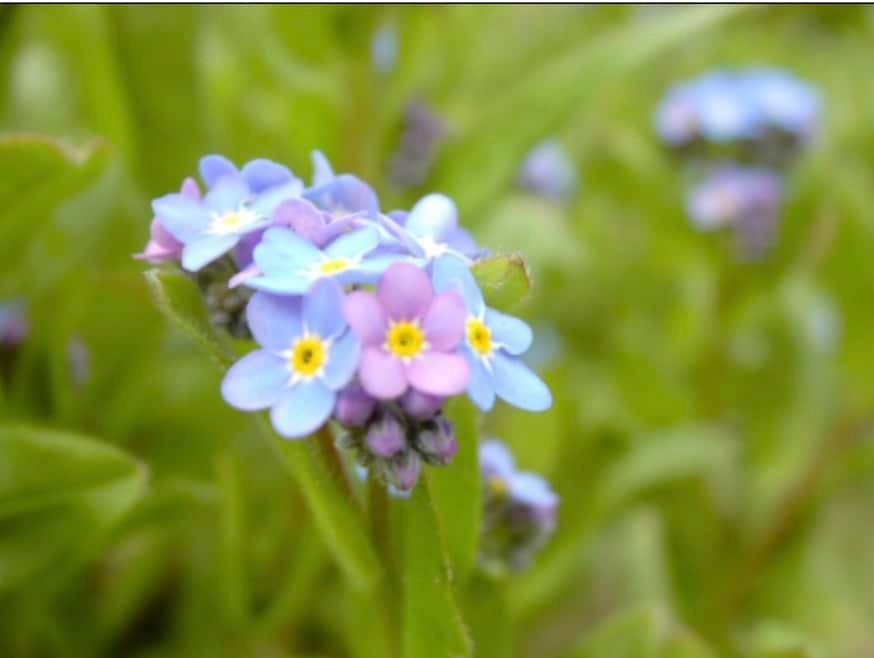
Forget-me-not
A little, tiny flower. But how beautiful!
Classification for forget-me-nots
Kingdom: Plantae (plants)
Subkingdom: Tracheobionta (vascular plants)
Superdivision: Spermatophyta (seed plants)
Division: Magnoliophyta (flowering plants)
Class: Magnoliopsida (dicotyledons)
Subclass: Asteridae
Order: Boraginales
Family: Boraginaceae (borage family)
Genus: Myosotis
Species: Myosotis scorpioides
Forget-me-nots belong to the genus Myosotis, which contains around 50 species of herbaceous plants. The species most commonly cultivated as a garden plant is Myosotis scorpioides. The Boraginaceae family also includes other popular garden plants, such as borage, comfrey, and heliotrope.
Flower meditation
Pictures mlaure
Video made with Canva
Music depositphotos
Characteristics
Here are some general characteristics of forget-me-nots
Size: Forget-me-nots are small, herbaceous plants that typically grow to be around 6-12 inches (15-30 cm) in height.
Flowers: Forget-me-not flowers are small and delicate, with five petals that are usually blue, pink, or white, and a yellow center. They are typically arranged in clusters along the stems.
Leaves: Forget-me-not leaves are small and ovate, with a slightly hairy texture.
Habitat: Forget-me-nots are native to Europe and Asia, and they are often found growing in damp meadows, along streams and rivers, and in other moist environments.
Growing Conditions: Forget-me-nots prefer cool, moist conditions and partial shade. They can be grown in a wide range of soils, as long as they are kept moist.
Reproduction: Forget-me-nots can reproduce by self-seeding, and they can also be propagated from stem cuttings.
Uses: Forget-me-nots are commonly grown as ornamental plants in gardens and landscapes. They are also used in traditional herbal medicine to treat a variety of ailments, including respiratory issues, headaches, and fever.
Forget-me-nots are charming and delicate plants that can add color and texture to any garden or landscape. They are relatively easy to grow and care for, making them a popular choice for gardeners of all skill levels.
Botanicals
The botanical name for forget-me-nots is Myosotis, which is derived from the Greek words “myos” meaning “mouse” and “otos” meaning “ear“. This refers to the shape of the plant’s leaves, which are said to resemble the ears of a mouse. There are around 50 species of Myosotis, and the most commonly cultivated species is Myosotis scorpioides.
Other common names for forget-me-nots include scorpion grass, mouse’s ear, and love-me-not. Forget-me-nots are part of the Boraginaceae family, which also includes other popular garden plants such as borage, comfrey, and heliotrope.
Planting and flowering season
Planting time and flowering season of forget-me-nots can vary depending on the species, climate, and location. Here are some general guidelines
- Planting time: Forget-me-nots are usually planted in the fall, about 6-8 weeks before the first expected frost, or in the spring after the last frost.
- Soil and location: Forget-me-nots prefer cool, moist conditions and partial shade. They can be grown in a wide range of soils, as long as they are kept moist.
- Planting depth: Forget-me-not seeds should be sown on the soil surface and pressed lightly into the soil.
- Flowering season: Forget-me-nots typically bloom in the spring, usually between April and June, depending on the species and location.
- Maintenance: Forget-me-nots require regular watering to keep the soil moist. They also benefit from occasional fertilization, and deadheading spent flowers can encourage the plant to produce more blooms.
Forget-me-nots are relatively easy to grow and care for, making them a popular choice for gardeners who want to add some color and texture to their gardens or indoor spaces.
Table summarizing the information about forget-me-nots
| Characteristics | Description |
| Size | Small herbaceous plants that typically grow to be around 6-12 inches (15-30 cm) in height |
| Flowers | Small and delicate, with five petals that are usually blue, pink, or white, arranged in clusters along the stems |
| Leaves | Small and ovate, with a slightly hairy texture |
| Habitat | Native to Europe and Asia, often found growing in damp meadows, along streams and rivers, and in other moist environments |
| Growing Conditions | Cool, moist conditions and partial shade, can be grown in a wide range of soils, as long as they are kept moist |
| Reproduction | Can reproduce by self-seeding, and can also be propagated from stem cuttings |
| Uses | Commonly grown as ornamental plants in gardens and landscapes, used in traditional herbal medicine to treat a variety of ailments |
| Botanicals | Myosotis scorpioides |
| Planting Time | Fall, about 6-8 weeks before the first expected frost, or in the spring after the last frost |
| Planting Depth | Seeds should be sown on the soil surface and pressed lightly into the soil |
| Flowering Season | Typically bloom in the spring, usually between April and June, depending on the species and location |
| Maintenance | Require regular watering to keep the soil moist, occasional fertilization, and deadheading spent flowers |
Shop Tip














